Somewhere mid-summer I decided to take a break and head for the coast. I found a room with a small kitchen close to the beach in Manzanita and I set out to do nothing but walk the beaches in the area and take pictures at my own pace. As COVID-era vacations go, it was just right. I also pulled the trigger on a Q2, Leica’s compact, fixed-lens, full-frame camera. I wanted to start this sentence with “Reasoning that a great vacation deserved a great camera,” but I have not, five months later, convinced myself that reason was involved.
For the past six years or so I have been shooting exclusively with Fujifilm cameras. An X100S got me into the X-series, an X-T2 was my entry point into their interchangeable lens bodies, and I have since had an X100F, X-Pro3, X-T4, and X100V. The X100 series is a wonderful “throw in your bag” camera: A versatile lens, and most of the capabilities of the interchangeable lens cameras in Fujifilm’s lineup. X100s have always been what I’ve reached for on family trips and business travel.
Someone asked me how the Q2 compared to its nearest analog in the Fujifilm lineup: the X100V. I got the question at bedtime over a Google Hangouts chat on my phone, pecked in an answer that I had to edit to fit in the message length limitations, and went to sleep. This is something a little more long form. If you want truly exhaustive reviews of these two cameras, go to Digital Photography Review, where you’ll get much more detail than I know to offer. (Spoiler alert: Both cameras get the “gold” award, and are within two points of each other in overall scores.)
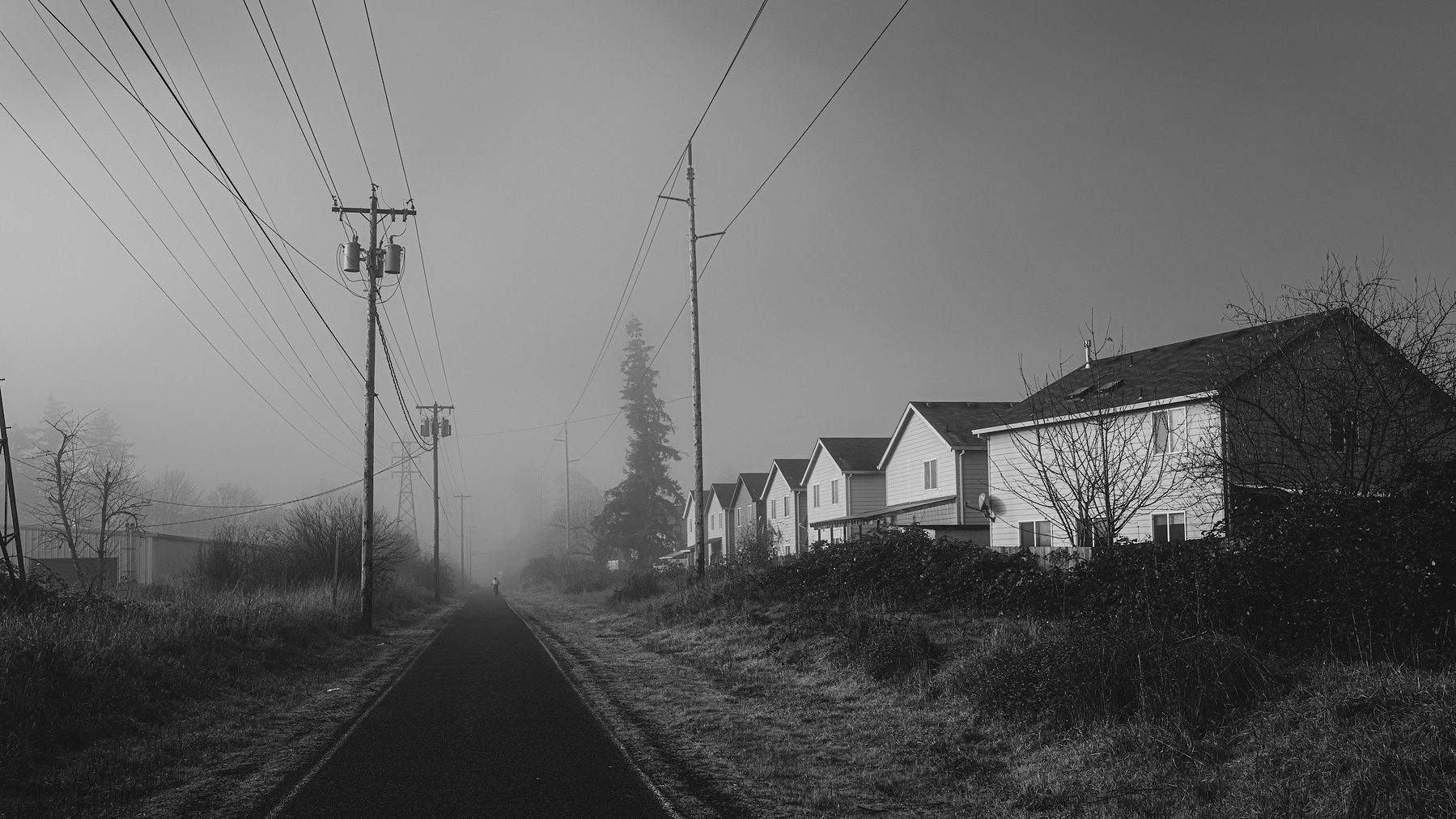
What you’re getting from me is a comparison of the things I care most about and can meaningfully differentiate, so I can’t tell you much about video–something Fujifilm cares about and which Leica only cursorily addresses in the Q2, which is a stills camera with some video capabilities. The other thing you’re getting from me is a studious avoidance of the more subjective end of the subjectivity range. I can tell you what I like about these cameras in terms of relative inarguability: It is both true that the X100V has a few more dedicated, physical controls and that I prefer that. I do not know if it’s true that Leica optics are “magical,” so I am not going to make any representations about said magic.
If you want to just get to my basic conclusion: The Q2 is a less flexible camera in terms of in-camera control, and I don’t like its handling quite as much as I like the X100V’s, but it produces better images, has a better lens, and its optical stabilization and better dynamic range make it a more flexible camera for my purposes, which involve a lot of night shooting.
I don’t think the Q2 is four times the camera an X100V is, and I can’t think of anyone I’d be in the position of recommending a camera to for whom I’d recommend it as the better choice: Dollar for dollar, the X100V is a much better camera for almost everybody interested in a premium compact camera. At the same time, now that I own the Q2 and have not returned it or sold it in a fit of guilt, I wouldn’t easily part with it: I love shooting with it, love what I get out of it, and expect to keep it for a long time. The only reason it is not my only camera comes down to its fixed, very wide lens, which makes portraits and some outdoor photography a relative challenge.
So, some comparisons:
Physical design 🔗
Both are weather resistant, meaning they can withstand some moisture and dust. The Q2 is that way out of the box while the X100V requires you to buy a filter and adapter ring. Living in Portland, I won’t buy a camera that is not weather resistant, and a lens needs to be pretty special before I’ll consider a non-WR one.
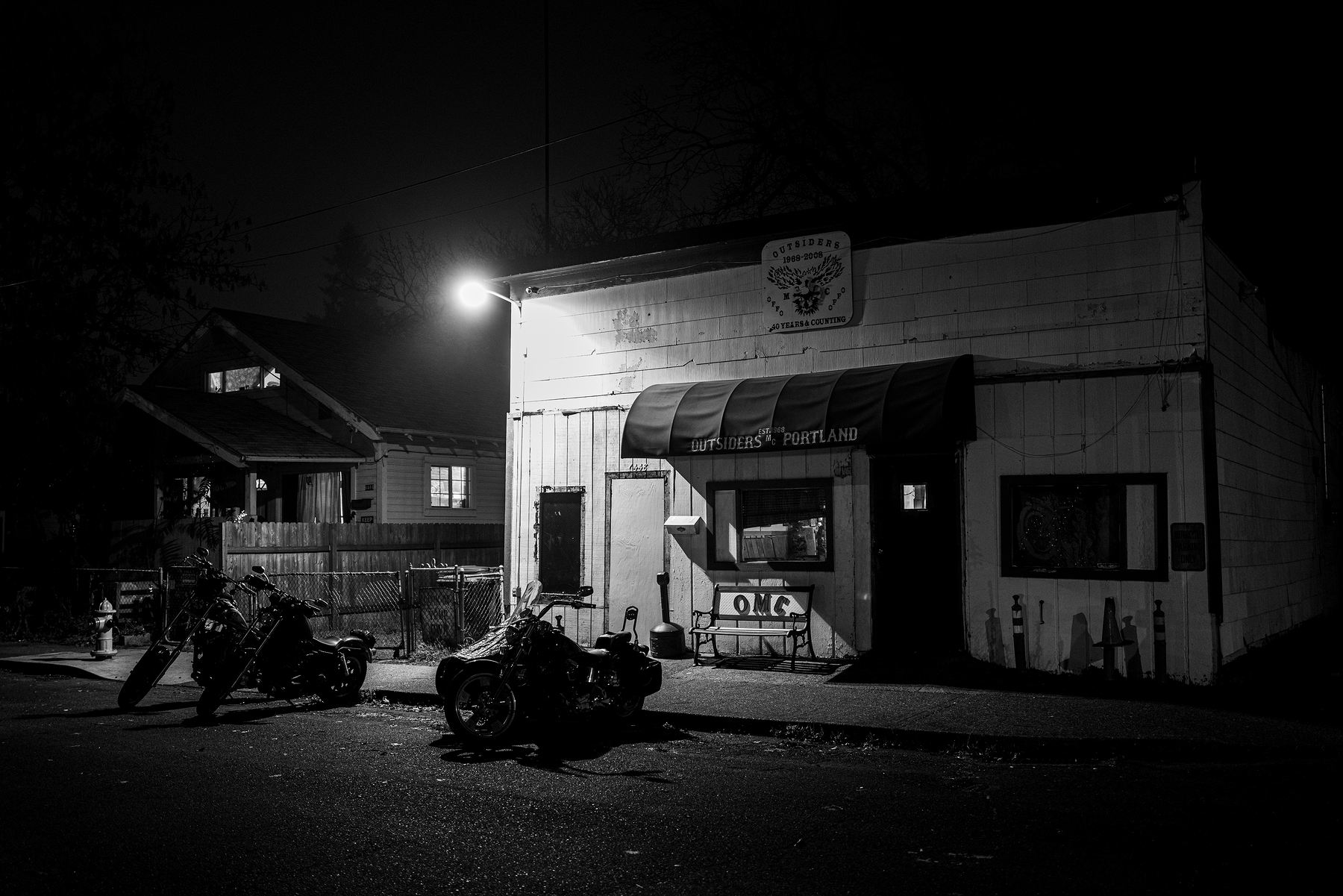
Both feel pretty solid in the hand. The bodies have similar dimensions, but the Q2’s lens is much bigger and surely contributes to its half-pound greater heft.
The X100V wants to look a little more vintage, so its rubbery body covering is textured to look like leather, while the Q2 opts for a crosshatched pattern.
The X100V offers a small handgrip, while the Q2 has a rear indentation for your thumb to ease clamping on to it.
The X100V stores battery and SD card in the same compartment, underneath a little hatch with a rubber seal. The Q2 keeps these separate, and the battery itself has a seal because its “compartment” is open: You slide the battery into its opening similar to a clip on a gun, and release it by pulling a lever and giving the battery a slight upward push to cause it to drop out of the body and into your hand.
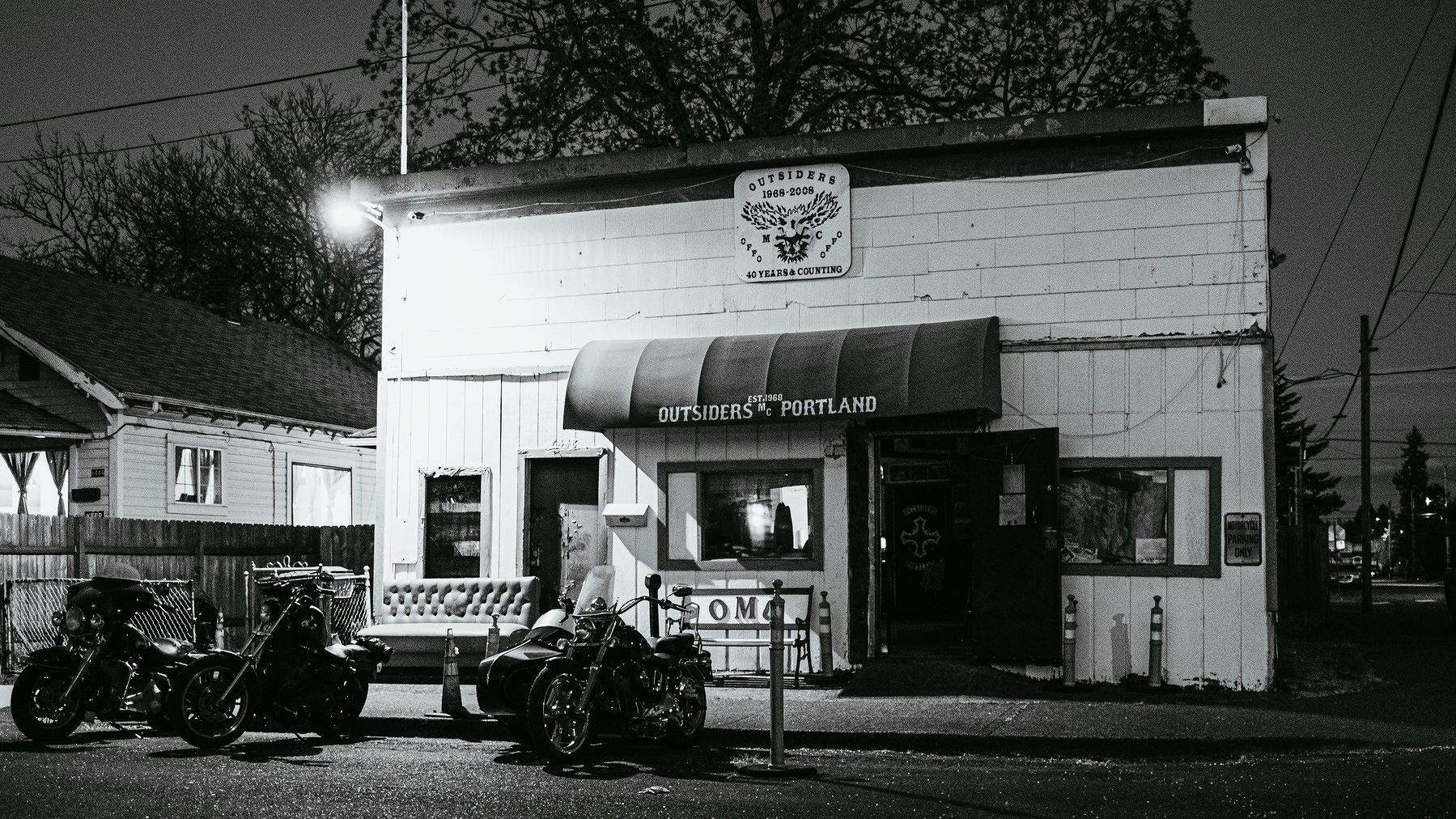
The X100V has a built-in flash that works just fine. The Q2 has none: Just a hot shoe.
The X100V has a number of ports including a mic port, a USB-C port that allows for charging via a cable, and a micro HDMI port. The Q2 doesn’t have any ports, at all, so batteries have to be charged with a dedicated charger and photos have to be downloaded either via the WiFi interface or with an SD card reader.
Lenses and sensors 🔗
In terms of raw lens and sensor specs:
- The Q2 has a 47mm, full-frame sensor; the X100V has a 26.1MP APS-C sensor.
- The Q2 has an f1.7, 28mm lens; the X100V has an f2, 23mm lens (making it roughly equivalent to a 35mm lens after sensor crop is taken into account). Since I’ve lived most of my (digital photography) life with APS-C sensors, it’s a little easier for me to think of the Q2’s lens as being roughly equivalent to an 18mm lens on one of my Fujifilm bodies.
I won’t go into sensor comparisons. Having not shot with a standard CMOS sensor in a long time, I will say that a few times I’ve run into the kind of moire with the Q2 that I’ve never had to deal with in a Fujifilm camera’s X-Trans sensors. It has been rare. The Q2 produces more subtle output, overall, and I’m always pleased with how much flexibility its DNGs provide: I try not to get too comfortable with that, but I’ve rescued a few images in Lightroom that would have been goners coming from another camera. I’d have said the same thing about the X100V’s RAW files not that long ago, too.
Comparing viewfinders and screens 🔗
The X100V’s hybrid electronic/optical viewfinder is one of its standout features. You can toggle between the two, and there’s something pretty cool about the overlay of shooting data on a non-electronic view. That said, I’ve become pretty spoiled by the accurate previews an electronic viewfinder presents, don’t like always wondering about parallax error, and sometimes shoot in monochrome mode as a compositional aid, so I almost never use the OVF. The Q2’s EVF is larger and clearer.
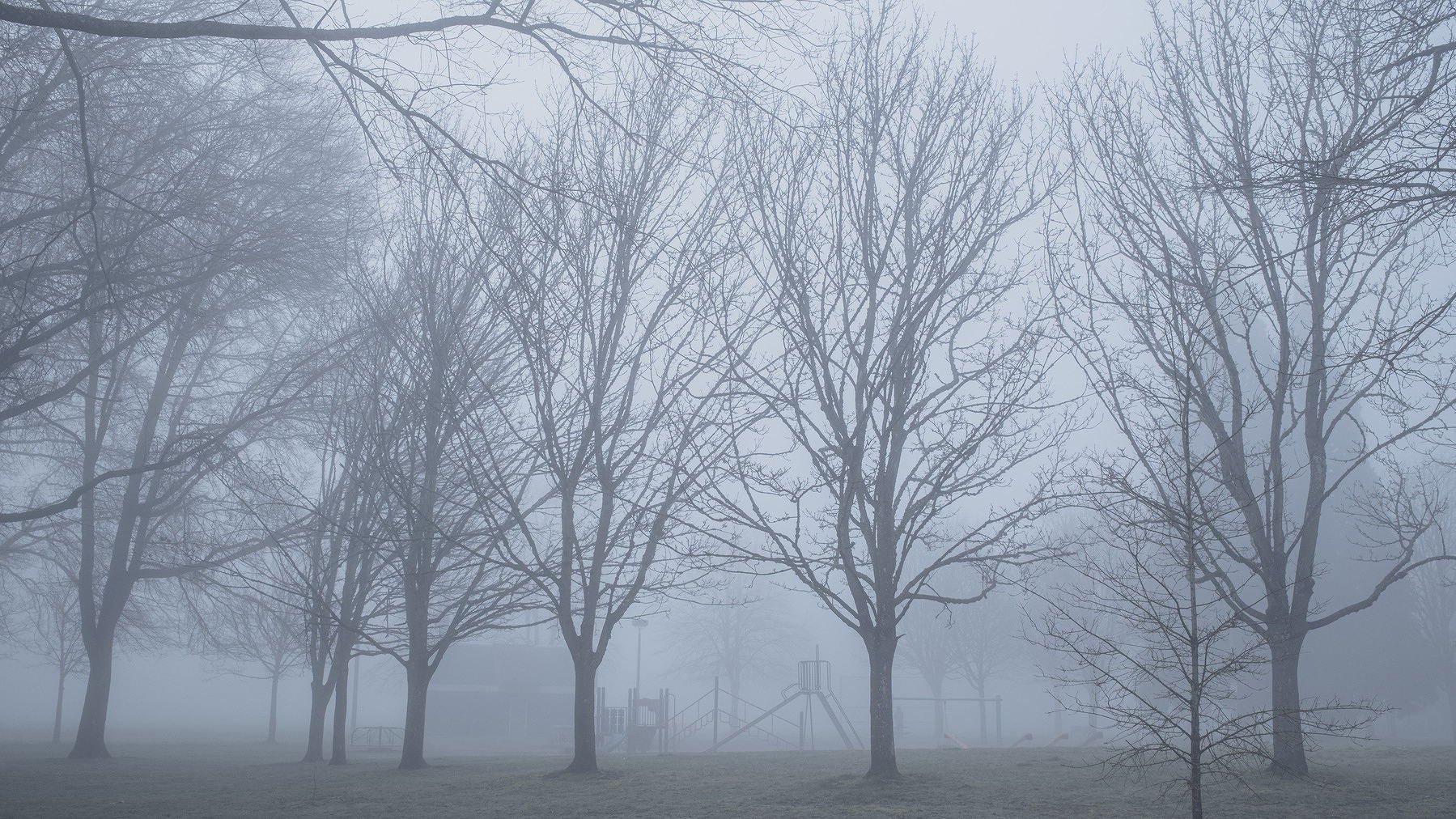
The X100V has a flip-out LCD that’s great for shooting at waist-level. The Q2 has a fixed LCD. I vastly prefer the flexibility of the X100V for street photography, where stealth helps, and for getting down close to subjects.
Both have touch controls, and I seldom use them on either. I never warmed up to the implementation on Fujifilm cameras, finding it a little cranky and preferring to look through the viewfinder to shoot; I simply haven’t experimented on the Q2, outside of using a double-tap center screen to recenter the AF point. I’m glad the emphasis on touch control is still apparently just an accommodation to phone photographers who are used to tapping a screen to focus, etc. and not core to the control experience.
Comparing Lenses 🔗
The X100V’s lens is comparable to the “Fujicron” 23mm/f2 on their interchangeable lens cameras, and I’ve come to think of 23mm as my “home” focal length on crop sensors: Great for capturing context on the street, able to do tourist landscapes, wide enough to provide some subject separation. It’s sharp and fast enough most of the time for night-time street shooting.
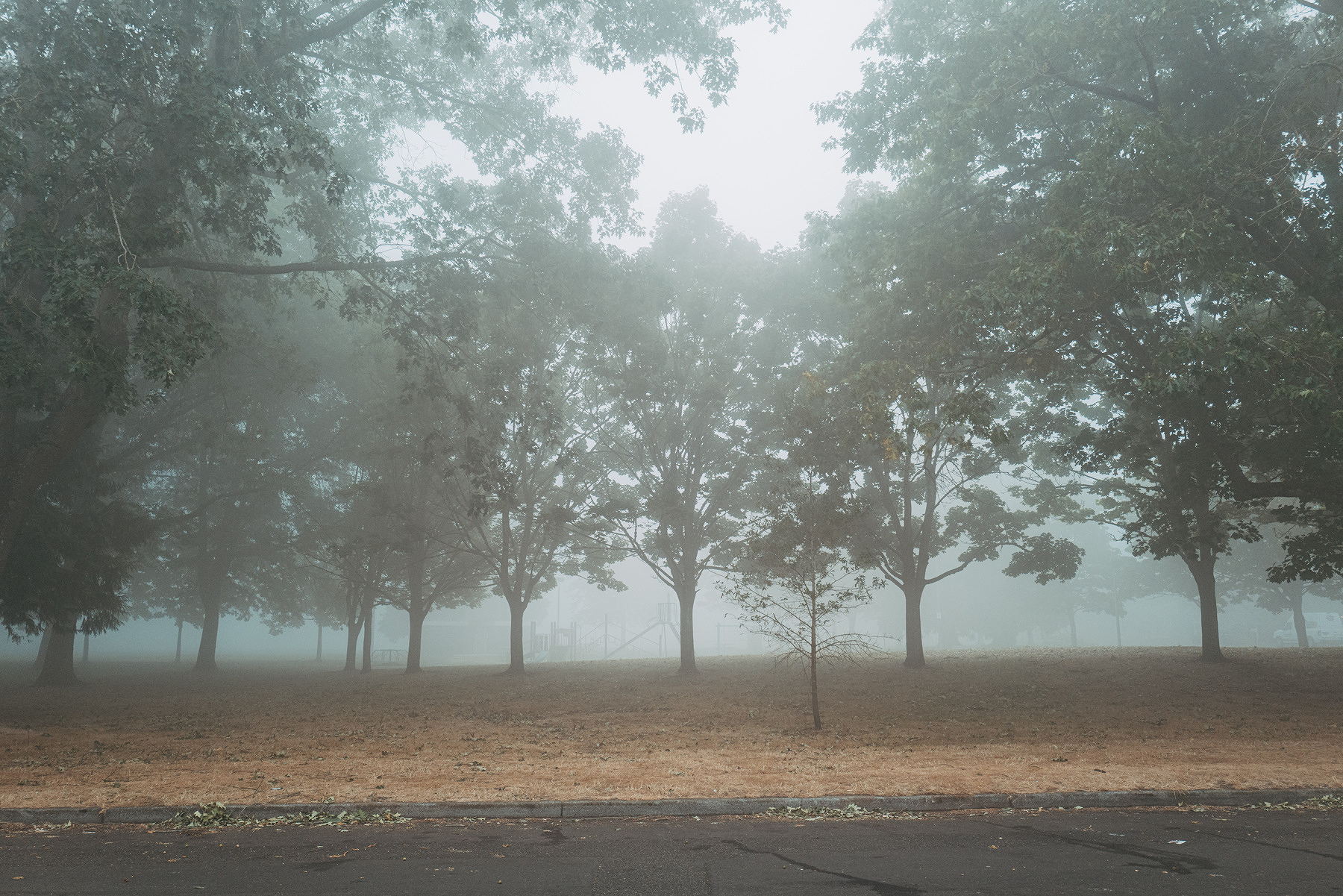
The Q2’s lens, at 28mm/f1.7, reminds me most of the 16mm/f1.4 on a Fuji body. Not quite as wide, but close enough to be noticeably different from the 23mm on the X100V. It is not, frankly, as comfortable a focal length for me. I’ve taken my 16mm lens on street shoots before, but it’s a hair wide for comfort. I do like taking it on hikes as my sole lens, because the wide aperture allows for some lovely bokeh in closeups of plant life or other details, but it’s plenty wide and sharp to capture a waterfall or landscape.
The Q2’s lens comes with a macro setting. Shot wide open and close up, you get amazing bokeh and detail. The depth of field is shallow enough that a slight breeze can upset the image.
The two lenses live on either side of a divide where portraits are concerned. With a little care, you can overcome the worst of the “hatchet face” effect on the X100V. On the Q2, the distortion of the 28mm lens is a little too much; or I have not figured out how to overcome it yet. It’s great for environmental portraits.
They also live on two sides of a metering divide: The Q2’s wide, 28mm lens can pull in a lot of sky and skew underexposed. The X100V’s (again, cropped) 23mm tends to cause less of that.
This is probably also a good point at which to note that both cameras have an optional digital crop/zoom, allowing them to simulate closer focal lengths: The Q2 allows for digital cropping to 35mm, 50mm, and 75mm. The X100V has 35mm and 50mm crops.
As I understand it, the Q2 is simply cropping, which makes the feature more of a compositional aid; and it works with both the DNGs and JPEGs the camera produces (the JPEGs are truly cropped, the RAWs keep all the data from the sensor but show up in Lightroom pre-cropped and restorable to the full image dimensions). When shooting DNGs, the viewfinder presents crop marks during composition. On review in the camera, it shows the cropmarks. When shooting DNG/JPEG or just JPEG, the viewfinder presents crop marks during composition, but shows the cropped image during review in the camera.
The X100V does a little more, applying some sort of digital upscale to improve over standard digital zooms. The X100V also limits the availability of the feature to JPEG shooting only. The feature isn’t available when capturing RAW/JPEG, either. In terms of UI, the feature works like a digital zoom: Using the EVF, it provides a zoomed image; while using the optical viewfinder it provides crop marks. The zoomed image in the EVF is pretty poor quality (perhaps to maintain the framerate of the display) and can put you off the feature pretty quickly until you see the actual images it produces, which aren’t bad at all, and stand up to all but determined pixel-peeping.
With both cameras, you aren’t getting the actual optical characteristics of the closer focal lengths … it’s still just a cropped image, so you’re not going to magically turn either camera into a portrait machine. Given you have a lot more pixels to work with on the Q2, the 35mm crop is still pretty good, providing a 30MP image – still higher resolution than the X100V at full resolution.
In either case, I’ve got a completely RAW workflow at this point, so the X100V’s digital crop isn’t available to me. On the Q2, it’s a useful compositional aid that I welcome given that the 28mm lens is wide for my tastes.
I suppose this is also the place to note that the Q2’s lens is stabilized (Leica says it’s good for 6 stops), while the X100V’s is not. Given that my primary shooting environment is Portland and most of my shooting is in the late afternoon or evening, the Q2 becomes enormously more flexible: I can easily hand-hold down to 1/8 at night and still get sharp, low-noise images. I wonder if IBIS is the next frontier for the X100 series: Having had it on the X-T4, and given the X100V has a newly redesigned lens, maybe it’s a feature they were holding back this time around, having previously claimed it was impossible on the X-Trans sensors. That doesn’t matter for this comparison: The X100V doesn’t have a stabilized lens so it necessarily produces noisier images at night when handheld.
Control and Handling 🔗
Both cameras emphasize physical controls, the X100V a little more full-throatedly. Both have actual aperture rings and shutter dials. The X100V has a dedicated exposure comp dial, while the Q2 has an unmarked dial in the same place that behaves like one by default. I prefer the X100V’s dedicated, marked dial because it’s easier to get it back to “0” without using a screen, which is great for street shooting, where I want to minimize the time I spend with the camera to my face or looking into its screen.
The X100V also has an ISO dial married to the shutter dial. The Q2 “exposure dial” has a button on top that turns it into an ISO dial, so ergonomically it’s close to a wash: I will always prefer a marked control, but this one in particular isn’t one I use much.
The X100V can switch between manual, automatic, and automatic/continuous focus modes with a dedicated switch. The Q2 has a thumb control on the lens barrel to do the same thing for manual and autofocus, but you have to go into a menu to turn on continuous tracking.
For moving the autofocus point around, the X100V has a little joystick nub/button, while the Q2 has a d-pad. One thing I love about the X100V is that you can return the AF point to center by clicking the joystick. On the Q2, the same thing happens with a doubletap in the center of the back LCD, which isn’t as easily done when you’re holding the camera to your face and trying to quickly get your AF point somewhere useful.
Both cameras also offer a lot of flexibility in how their buttons work. The X100V is a little more flexible and has more buttons on the body overall. The Q2 uses long-presses to make some of its buttons multi-function. The “fn” button, for instance, lets you set what option it will control with a longpress, then make that option available from a short-press. The right-wheel button behaves similarly. In both cases, you can customize which options live under each button, providing quick access to 16 functions.
Both also offer a rear LCD menu. Fujifilm calls this the “Q menu” across all its X-series cameras. On the Q2 you get a fixed menu of options that are pretty common sense choices. The X100V offers much more control of its equivalent Q menu: You can adjust the number of available options, and mix and match many, many settings. I prefer it much more, but I’m about to get into a difference in philosophy between these two cameras that renders the difference close to moot.
In terms of saving settings presets, the X100V offers seven slots where you can save film simulation, shadow/highlight tone, saturation, etc. and then name each one. When I had a more JPEG-heavy workflow, I saved several combinations of shadow and highlight tone at various extremes, and a few more neutral variations, then tied switching film simulations to a button I could get at easily. The net result was easy access to seven sets of custom settings times however many film simulations I cared to use. It’s a good system that allows for a lot of experimentation. The missing next step for the system is to allow use of those custom settings when exporting a JPEG in-camera: Today, that operation requires you to hand-select every setting you want to change before preview and save. Even better would be “preset bracketing.” Today you can do film simulation bracketing, which is nice but not all the way there.
The Q2 has user profiles, which do some of the same thing and can also be renamed. Because of the direction Leica has gone with settings overall, these feel less useful as a creative exploration tool and more as a way to specify profiles by shooting conditions and environments (e.g. night, day, indoor, outdoor, etc.)
I tend to prefer Fujifilm’s approach to controls and like the flexibility of the Q menu. I find the Q2’s menu system cleaner and less bewildering/tedious. It is also exposing much less to control.
One other area where I prefer the X100V is in changing settings on the Q menu: You can use the joystick to move to a setting, then use the thumbwheel to cycle through options. On the Q2’s comparable menu, you have to click into the option to change it. It’s a bit slower and less efficient.
Ultimately, the X100V feels more customizable and tunable for individual use cases because it offers a few more buttons and switches you can remap to taste. The Q2 is a bit more opinionated in that regard and has fewer physical controls to remap. While it is pretty flexible, it is still less so than the X100V.
The mobile experience 🔗
I should probably note the great tragedy of Fujifilm’s X system, which is its mobile app. For a camera devoted to producing publication-ready images, the Fujifilm mobile app is a catastrophe: Cranky, unreliable, slow. I hate it and won’t use it, preferring instead to carry an SD card reader around for direct import to phone or tablet, and using a dedicated device for remote capture.
Leica’s FOTOS app is far more reliable and simple to use, but downloading full resolution DNGs or JPEGs from a full-frame camera is time- and battery-consuming, and with my workflow they need to go through Lightroom anyhow. Fujifilm should poach whatever team is working on FOTOS: Q2 shooters won’t miss them, and Fujifilm’s CSAT scores will surely triple overnight.
If you absolutely must download images from the X100V instead of using a card reader, there’s an option to reduce the size of the downloaded images to 3MB, which shortens download times and increases your chances of completing a download before the inevitable disconnect.
Some people say they have a lot of luck with the app, by the way. I happen to have found it uniformly bad over three generations of Fujifilm cameras. Even if it were amazingly reliable, it would still be slower than a USB-C SD card reader connected directly to my iPad.
So let’s get to that philosophical stuff:
Comparing philosophies 🔗
The two cameras occupy a similar niche, to the extent they are fixed-lens, compact, weather-resistant, “take with you everywhere” devices. While their lenses are a bit different, they’re still just two opinions on the same question, which is how to provide maximum versatility: Just wide enough to capture a sweeping vista, and teetering on the edge (but just missing, IMHO) of being close enough to capture an intimate portrait. The Q2 requires you to be a little more brave in your street photography if you want tighter framing; the X100V will sometimes make you leave a little out of that landscape.
On the inside, though, they diverge more profoundly.
The X100V presents more like an old-school rangefinder on the outside, with maximum physical control, but provides a software feature set that is much more interested in providing more heavily processed images straight out of the camera.
The Q2 presents a more modern, streamlined face, and is much less interested in producing processed images. In fact, its JPEGs are so … just fine … that it effectively directs you toward a RAW workflow.
Let’s start with the two cameras’ approaches to basic image styling:
The fundamental building block of the X100V’s notions around image style is its collection of “film simulations,” most of which are designed to emulate the basic characteristics of Fujifilm’s film stocks: Vivid Velvia, soft Astia, cinema-like Eterna, and moody, monochrome Acros (along with several filter options to go with to effect contrast). There are a few more, including a pair of very neutral options and “Classic Chrome.”
The Q2 is way more staid: It offers “standard,” “vivid,” “natural,” “natural black and white” and “high contrast black and white” settings it refers to as “film styles.” You can affect a few variables within each preset to your taste: contrast, sharpness, and (for the color styles) saturation. Those options travel along with each film style, and it takes a little menu delving to change them.
Fujifilm breaks out those basic options (and more), allowing for a much more flexible approach to in-camera image styling: In addition to saturation and sharpness, you get tone control for shadows and highlights, plus the vintage-y “color chrome” & “chrome blue” settings, grain, clarity (midtone contrast) and more.
Given a little up-front work with an X100V, you can produce very distinctively styled images right in the camera, bending whatever line you care to imagine exists between plain old digital darkroom work and the more tasteful end of VSCO’s filter selection. You can also re-process RAW images in-camera to apply new settings and save a new JPEG to your memory card.
The Q2 offers little of this flexibility: To get the most out of your images, you’re going to be headed to Lightroom or whatever your preferred darkroom tool is.
I don’t think one philosophy is better or worse. Both cameras, at their core, make beautiful images.
Fujifilm is doing some interesting things with its cameras and software across its product line. The XPro-3, for instance, was a pretty polarizing camera thanks to its hidden rear LCD and implicit stance against reviewing your images right after taking them (aka “chimping”). People made all sorts of claims about the value of this approach, choosing to ignore that you can choose not to chimp, can often simply turn off the rear LCD, and can even just flip it closed in a lot of cases. That Fujifilm did this while also making the previously marquee feature hybrid viewfinder less useful and functional compared to previous versions suggested that perhaps the camera was becoming less about perfecting the device and more about perfecting the mood it is meant to evoke.

So, too, does it go with the X100V’s film simulations and the choices Fujifilm is making about which creative settings are going in: The color chrome and chrome blue settings, for instance, are meant to further augment the throwback vibe of the Classic Chrome film simulation.
Taken together, you get the feeling Fujifilm is looking to stake some ground as a lifestyle brand through its industrial design and creative control choices. Years ago, when I sold my X100S to a friend to fund my next camera purchase, his wife, on seeing the camera, dryly noted that “I didn’t know Mike was a hipster.” At the same time, Fujifilm’s cameras, the X100V included, aren’t losing integrity as picture-taking machines. You don’t have to use any of the creative control stuff, and having lots of physical controls can be an aesthetic choice but is also a very practical one: I owned a Sony mirrorless camera for about 18 hours four years ago, and took it back because I simply preferred Fujifilm’s approach to controls and interfaces for utilitarian reasons.
I want to make clear, though, that Fujifilm’s efforts to evoke a particular mood don’t really limit your choices: There is so much flexibility in the interface and the Q menu is so customizable that you can pretty much recreate, for instance, the much less flexible LCD control panel on a Q2 (or any other digital camera). You can leave the vintage effects on the table, never seeing or using them. As much as Fujifilm is making it easy for you to take your photos in a sort of vintage-y direction, it is not making one-note novelty toys.
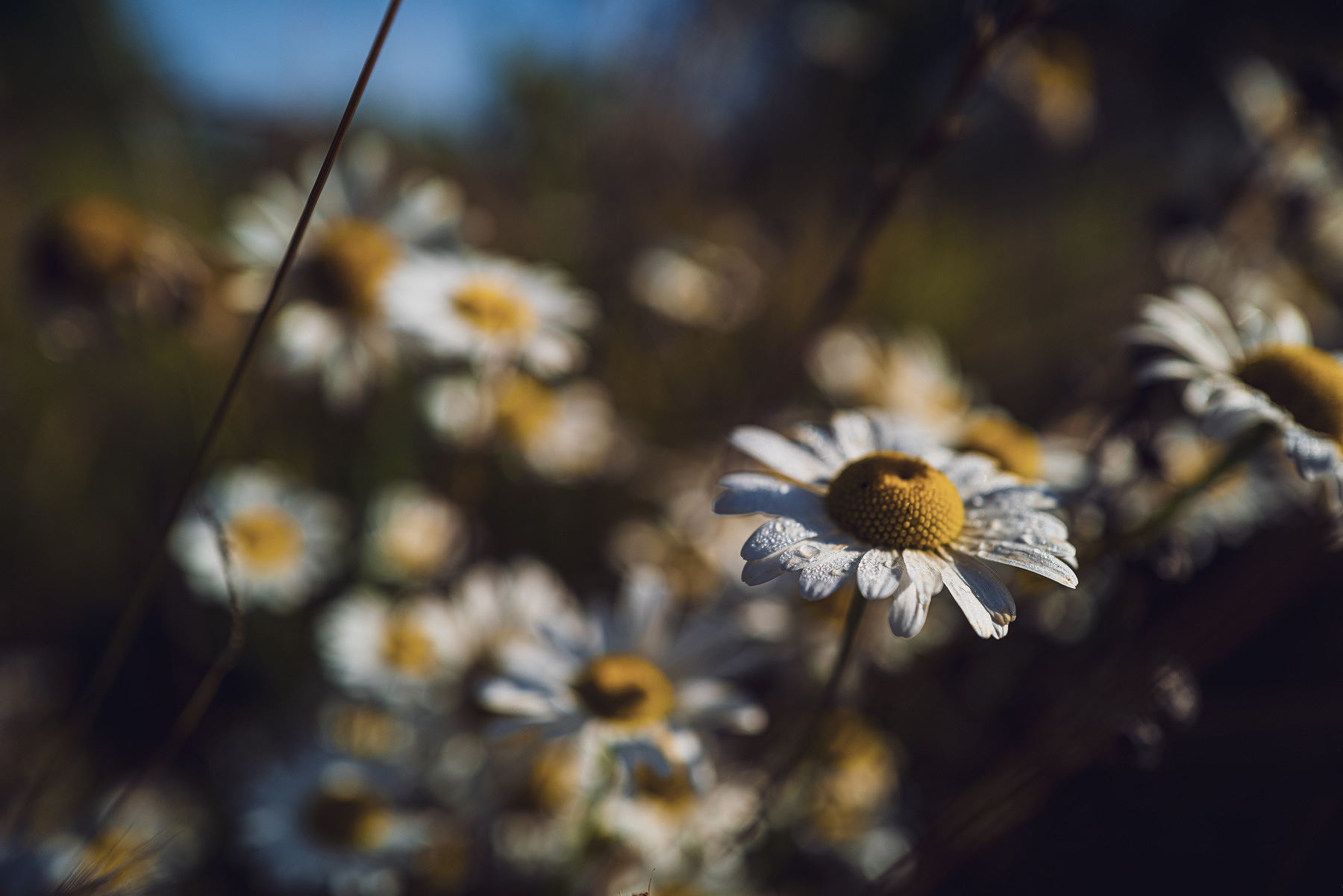
The Q2 feels less interested in evoking a particular mood, does not provide creative controls that are meant to remind you of vintage film or its visual characteristics, and is content to let the Leica marketing department handle all the heavy lifting of making it less about “retro” and more about participating in a brand’s lineage.
Philosophically, then, the Q2 seems to assume you either want to produce images within a pretty narrow baseline of output, or intend to do your creative processing in post production.
If you’re the type to simply compare feature lists, you sort of have to give the nod to the X100V: It packs more options into the camera itself and provides more in-camera creative tools. For a certain kind of shooter, it is the more efficient choice because for that shooter it might remove the need for all but the most cursory work in post.
Maybe that’s worth a digression, even:
For the past while, we’ve watched the camera industry go into a slump: The low end point-and-shoot market has been eaten alive by capable smartphone cameras, which are offsetting their smaller sensors and lenses with amazing computational photography leveraged by very capable AI-driven processing engines. There are cases where my newish iPhone outperformed my Fujifilm cameras in tricky lighting situations in terms relative to their respective use cases; meaning that the iPhone output looked much better in its target media (phone, tablet, laptop screens) than the Fujifilm output would without significant post production work.
Traditional camera makers are eyeing this trend with some nervousness. A Sony executive, in the process of defending the viability of their interchangeable lens product line, came out and identified the divide as one between “glass” – big lenses and big sensors – and “computational,” or small lenses and sensors augmented with AI-driven image processing.
On the spectrum of premium fixed lens shooting experiences – the latest iPhone, the latest X100-series, and the latest Q-series – the X100V represents a dipping of the toes into solving hardware limitations (Fujifilm has staked turf on the idea that APS-C is enough for just about anybody) with computation. Its digital zoom feature isn’t as passive as the feature has been in past generations, and it offers more tools you’d once expect to handle in post. That has created some experience gaps, too: Turning the clarity setting on involves a 1-2 second delay as the image is processed and saved. The Q2 is still pretty committed to a more traditional workflow: You point your expensive glass and sensor at the subject, release the shutter, and wait to do anything significant in post. There’s an HDR mode, but it’s nowhere as flexible as Fujifilm’s.
If you’re a JPEG shooter, the Fujifilm approach is probably more appealing: Once you lock in a preferred look and save it to one of seven memory slots, your photos can go direct to wherever you prefer to publish without any post-processing and a high degree of individual style. The Q2’s JPEGs are pretty neutral in affect, even after a recent update meant to address complaints about them, and I imagine many people will want to punch them up in post at least a little.
If you’re a RAW shooter, it’s a little more (and less) complicated: Lightroom users (of which I am one) will be aware that not much in-camera customization comes over on import: Fujifilm RAW images can include the film simulation, but few of the other settings. The Q2 is in an even less sophisticated boat: Lightroom imports the RAW and applies little of the in-camera processing at all that I can discern.
The net effect of all this for me, as a RAW shooter, is that I’ve written a few Lightroom presets that I use at import for my Fujifilm and Q2 images alike. Since the Fujifilm film simulations are only available for images from the X100V, those presets tend to use Adobe’s RAW presets, which are fine starting points. I will use in-camera settings as visualization aids, but my Lightroom import presets determine where I start my digital darkroom work.
Conclusion(ish) 🔗
I love both these cameras, and would ultimately love some fusion of the two: The Q2’s sensor and lens specs are better and it is the more flexible camera for my use cases as a result, but I do love the X100V’s more generous physical controls and flexible UI: The Q2 is a small but livable step back in that regard. Because I have a very post-production-oriented workflow, most of the X100V’s in-camera creative options are lost on me, as much as I like the aesthetic and have a few personal Lightroom presets that can nudge my images in that direction on import.
I never choose the X100V over the Q2 when I’m headed out the door: the one “advantage” it would have for my purposes is a slightly more comfortable focal length, which the Q2’s crop function effectively removes while still providing more pixels to work with. I sometimes choose my X-T4 because it has the flexibility of interchangeable lenses and excellent image stabilization, or because I am in a particular mood and have a small collection of Lensbaby and novelty lenses that pair well with the camera’s creative options. I’ll probably sell the X100V soon enough, because it doesn’t really have a place in the lineup, but I have a lot of affection for the X100 series and Fujifilm cameras in general; the Q2 is simply a few steps up (but probably not four steps up) from the X100V.
Some links 🔗
- A gallery of Q2 images in varying states of edit: I just filtered Lightroom for images I flagged as keepers, so you can see a range of styles and some half-finished ideas.
- A gallery of X100V images in a similar state of curation.
- DPReview’s side-by-side comparison tool, where you can see a number of specs side-by-side. It really drives home how feature-rich the X100V is.